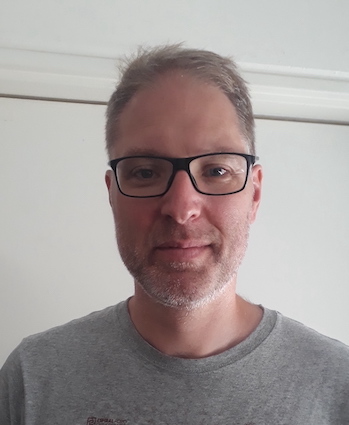
Soft condensed matter scientist – CNRS research director
I am a soft condensed matter theorist interested in understanding self-assembly, phase behavior and dynamical aspects of a variety of soft matter systems, with a focus on colloidal systems and lyotropic liquid crystals. Most systems I study are subject of ongoing experimental research and/or have a strong technological relevance. Examples include condensed phases of filamentous virus, motile bacteria, cellulose nanocrystals, clays, living polymers, colloid-polymer mixtures, and nematic colloids.
Research interests
- Self-assembly and dynamics of liquid crystals and polymers
- Phase behavior of colloidal systems and colloid-polymer mixtures
- Emergent behavior of active matter
Education
- 2004: PhD Physical Chemistry, Utrecht University, The Netherlands
- 2018: Habilitation à diriger des recherches (HDR), Université Paris-Saclay, France
Latest:
Contact information
Laboratoire de Physique des Solides – UMR 8502
Université Paris-Saclay & CNRS
Bâtiment 510
91405 Orsay Cedex, France
Office: S316 (south wing, 3rd floor)
Email: rik (dot) wensink (at) cnrs (dot) fr
Skype: rik.wensink
Career background
senior CNRS researcher (DR), Laboratoire de Physique des Solides, Orsay, France
2012: I joined the theory group of the Laboratoire de Physique des Solides (LPS) as a CNRS researcher to nucleate the current Soft Matter Theory unit.
« Akademischer Rat », Düsseldorf University, Germany
2010 – 2011: I rejoined the Theoretical Physics group as a postdoctoral fellow to collaborate with Hartmut Löwen on computer simulation of emergent behavior in active matter.
Ramsay Fellow, Imperial College London, UK
2008 – 2009: I joined the Chemical Engineering group as a Ramsay scholar to develop thermodynamic theory of chiral liquid crystals in collaboration with George Jackson.
Humboldt Fellow, Düsseldorf University, Germany
2005 – 2007: I joined the Theoretical Physics group headed by Hartmut Löwen as a Humboldt postdoctoral fellow to study a variety of topics related to driven and complex colloidal liquid crystals using numerical modelling.
PhD, Utrecht University, The Netherlands
2000 – 2004: During my PhD project I worked on a theoretical study of the phase behavior of mixed-shape colloidal liquid crystals at the van ‘t Hoff Laboratory under the supervision of Henk Lekkerkerker and Gert Jan Vroege.
Directed soft matter: nanoparticle-based liquid crystals
Our research is devoted to unravelling the microscopic principles that underpin self-assembly, phase behavior and dynamical aspects of a variety of soft matter systems. Our interest goes to systems that are subject of ongoing experimental research and/or have a strong technological relevance. Examples include filamentous virus, motile bacteria, cellulose nanocrystals, clays, living polymers, colloid-polymer mixtures, and nematic colloids.
The common thread characterizing these systems is that different sources of entropy – related to orientations, steric avoidance, mixing, polymer-backbone flexibility or depletion – conspire with weak enthalpic forces emerging from chirality, surface anchoring or living polymerization and active transport to generate a rich variety of self-assembled structures and phase behaviors with well-defined and facile reconfigurability.
Key manifestations of such complexity are spontaneous handedness inversions in chiral fluids, multiphase coexistence in colloid-polymer mixtures, empty lamellar fluids of non-convex colloids, self-sustained turbulence in bacterial flow, low symmetry fluidity in nematic colloids, or tunable photonics of lamellar clays.
As part of an international research consortium funded by the European Innovation Council in 2022 we have begun modelling complex mixtures of rod-shaped cellulose nanocrystals with adsorbing, actuable co-polymers for use as 3D printable biomimetic muscles.
Our approach to understanding soft matter is to start from coarse-grained, particle-based models that mimic the (orientation-dependent) interaction between the constituent nanoparticles. Subsequently, we invoke common tools from classical statistical mechanics such as variational and scaling theory, density functional methods and computer simulation to address collective properties such as phase behavior, diffusive dynamics and response to external stimuli.
Some topics of current interest are:
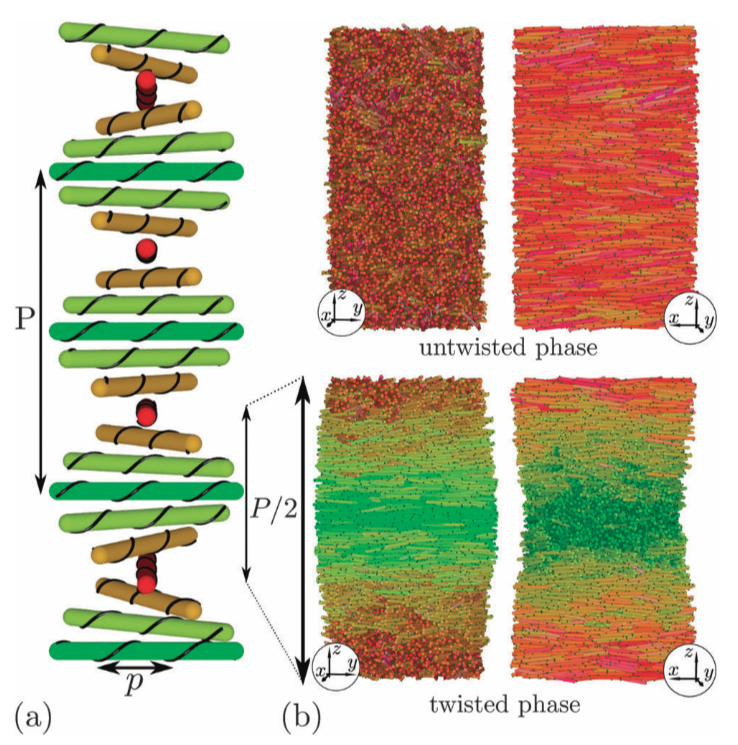
Chirality in liquid crystals
Chirality is generally the absence of symmetry and plays a key role in biological matter and, more specifically, in liquid crystals (LCs). The mechanisms underpinning the helical organization of the nematic director and its handedness are, however, rather unclear even in simple systems. We design simple coarse-grained LC models that enable us to address fundamental questions such as ‘‘How does the helicity propagate from the macromolecular to the supramolecular scale?’’ and ‘‘What are the fundamental physical aspects that control their left- or right-handed symmetry?’

Hybrid molecular-colloidal liquid crystals
Colloidal rods or discs immersed in low-molecular weight liquid crystalline host medium experience much more intricate interactions than in the case of simple isotropic media. Elastic distortions of the molecular director field induced by the presence of colloidal particles result in defect-mediated elastic colloidal interactions, which emerge to minimize the free energy cost of the colloidal inclusions. Along with emerging colloid-colloid interaction these surface-anchoring effects may stabilize colloidal nematic fluids with, for instance, orthorhombic and monoclinic point group symmetries. Together with the experimental group of Ivan Smalyukh we explore the rich behavior of these new classes of liquid crystals using simple theoretical concepts.
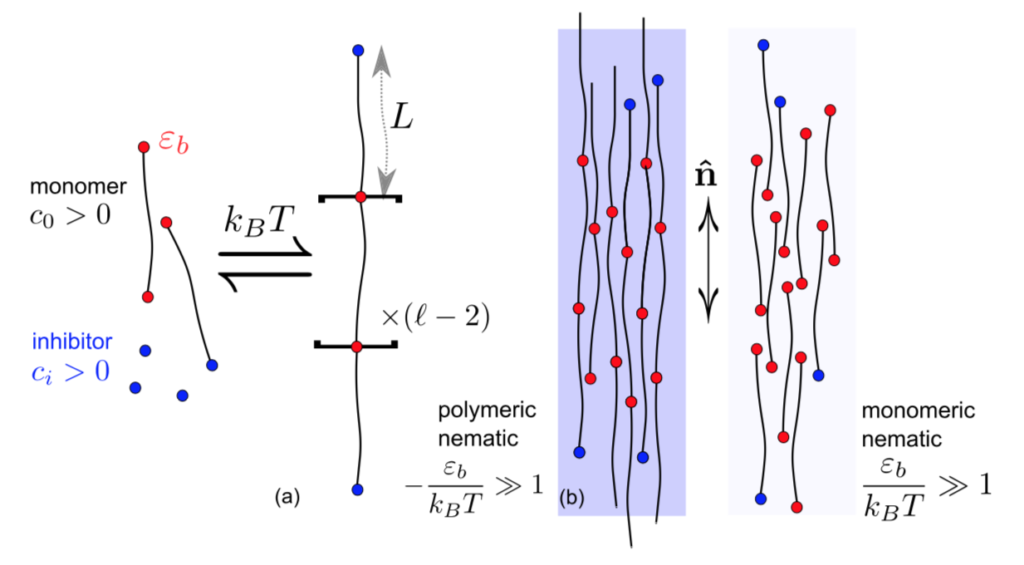
Self-assembly of directed living polymers
Self-assembly through reversible polymerization plays a key role in numerous processes in both passive and living soft matter. Microtubules, actin, and other filaments found in the cell cytoplasm are composed of dynamically organizing molecular units forming highly interconnected structures that provide essential mechanical functions to the cell. Rigid filaments may hierachically self-organize into liquid crystals (LCs). We theoretically study LC order of living polymer in complex environments due to, for instance, the presence of polymerization inhibitors and non-adsorbing colloidal discs that act as a « orientational » templates.

Size-polydisperse colloids
Polydispersity is ubiquitous in colloidal and polymeric sys-tems given that their constituents are hardly ever fully identical but exhibit a continuous spread in size, shape, or charge. A disparity in microscopic interactions can have a considerable impact on the phase stability as well as on the mechanical properties of colloidal and nanoscale materials via aggregation, packing, and percolation processes. We are interested in understanding the role of size dispersity in driving multiphase coexistence, in particular, nematic-nematic demixing as well as its impact on mesocale chirality.
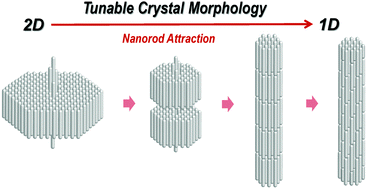
Depletion effects in colloidal self-assembly
Depletion effects arise when large colloids are mixed with small non-adsorbing species (such as simple polymers) that induce an effective attraction between the colloids. These attractions are entirely of entropic nature and are tunable through the size and concentration of the depletants. The effect lead to rich myriad of phase behaviors and self-assemblies that we study using free-volume theory and density functional theory.
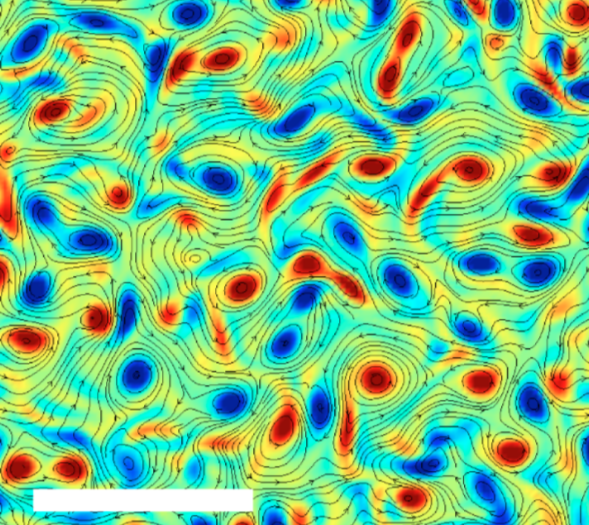
Active matter
Active matter relates to systems that are intrinsically out-of thermal equilibrium and are composed of molecular, colloidal or granular units capable of taking up energy from their immediate surroundings and engage in active processes such as replication or locomotion. Prominent examples include swimming bacteria or algae, self-propelled colloids and driven granulates. Using computer simulation we address complex emergent behavior of these systems such as bioturbulence, swarming and anomalous long-time diffusion.
Peer reviewed publications
2025
- Freezing in flat monolayers of soft spherocylinders
J. Mandal, H. H. Wensink and P. K. Maiti
submitted (2025)
2024
- Emergent biaxiality in chiral hybrid liquid crystals
J.-S. Wu, M. Torres Lázaro, H. Mundoor, H. H. Wensink and I. I. Smalyukh
Nat. Commun. 15, 9941 (2024) - Macroscopic observation of a first-order one-dimensional swelling-deswelling transition in a nanolayered material
O. Trigueiro Neto, K. Huseby Olsen, H. H. Wensink, B. Pacáková and J. O. Fossum
Eur. Phys. J. Spec. Top. 233, 2809 (2024) - Large-area, self-healing block copolymer membranes for energy conversion
C. M. Sproncken, P. Liu, J. Monney, W. S. Fall, C. Pierucci, P. B. V. Scholten, B. van Bueren, M. Penedo, G. E. Fantner, H. H. Wensink, U. Steiner, C. Weder, N. Bruns, M. Mayer and A. Ianiro
Nature 630, 866 (2024)
[Highlighted in CNRS Physique, Phys.org, Smart Water Magazine, AlphaGalileo, GFP, TrustedInsight] - Complex smectic phases in polymer-grafted shape-uniform cellulose nano-crystals
W. S. Fall and H. H. Wensink
Macromolecules 57, 8957 (2024)
2023
- Crystalline restacking of 2D-materials from their nanosheets suspensions
L. Cherni, K. El Rifaii, H. H. Wensink, S. M. Chevrier, C. Goldmann, L. J. Michot, P. Davidson and J.-C. P. Gabriel
Nanoscale 15, 18359 (2023) - Pre-smectic ordering and the unwinding helix in Monte Carlo simulations of cholesteric liquid-crystals
P. E. Brumby, A. Kowaguchi, T. Nozawa, K. Yasuoka and H. H. Wensink
J. Phys. Chem. B 127, 7194 (2023) - Elastic response of colloidal smectic liquid crystals: insights from microscopic theory
H. H. Wensink and E. Grelet
Phys. Rev. E 107, 054604 (2023) - Evidence of T-type structures of hard square boards in capillary confinement
R. Aliabadi, S. Nasirimoghadam and H. H. Wensink
Phys. Rev. E 107, 054117 (2023) - Multi-phase coexistence in binary hard colloidal mixtures: Predictions from a simple canonical theory
J. Obdam, V. F. D. Peters, H. H. Wensink and R. Tuinier
J. Phys. Chem. Lett. 14, 199 (2023)
2022
- Do aqueous suspensions of smectite clays form a smectic liquid crystalline phase ?
K. El Rifaii, H. H. Wensink, F. Puchtler, I. Dozov, T. Bizien, L. J. Michot, J.-C. P. Gabriel, J. Breu and P. Davidson
Langmuir 38, 14563 (2022) - Capillary-driven biaxial planar and homeotropic nematization of hard cylinders
R. Aliabadi, S. Nasirimoghadam and H. H. Wensink
Phys. Rev. E 105, 064704 (2022)
2021
- Second-virial theory for shape-persistent living polymers templated by discs
M. Torres Lázaro, R. Aliabadi and H. H. Wensink
Phys. Rev. E 104, 054505 (2021) - Fine tuning the structural colours of photonic nanosheet suspensions by polymer doping
K. El Rifaii, H. H. Wensink, C. Goldmann, L. Michot, J-C. P. Gabriel and P. Davidson
Soft Matter 17, 9280 (2021) - Multi-Phase Coexistences in Rod–Polymer Mixtures
V. F. D. Peters, Á. González García, H. H. Wensink, M. Vis and R. Tuinier
Langmuir 37, 11582 (2021) - Nematoelasticity of hybrid molecular-colloidal liquid crystals
B. Senyuk, H. Mundoor, I. I. Smalyukh and H. H. Wensink
Phys. Rev. E 104, 014703 (2021) - Thermally reconfigurable monoclinic nematic colloidal fluids
H. Mundoor, J.-S. Wu, H. H. Wensink and I. I. Smalyukh
Nature 590, 268 (2021)
[Highlighted in Phys.org, Bioengineer.org, Mirage News, ScienceDaily, EurekAlert!, NewsBeezer, CU Boulder Today]
2020
- Destabilization of the nematic phase of clay nanosheet suspensions by polymer adsorption
K. El Rifaii, H. H. Wensink, T. Bizien, J-C. P. Gabriel, L. Michot and P. Davidson
Langmuir 36, 12563 (2020) - Defying Gibbs’ phase rule: Evidence for an entropy-driven quintuple point in colloid-polymer mixtures
V. F. D. Peters, M. Vis, Á. González García, H. H. Wensink and R. Tuinier
Phys. Rev. Lett. 125, 127803 (2020) - Algebraic equations of state for the liquid crystalline phase behavior of hard rods
V. F. D. Peters, M. Vis, Á. González García, H. H. Wensink and R. Tuinier
Phys. Rev. E 101, 062707 (2020) - Tetrahedrality dictates dynamics in hard spheres
S. Marín Aguilar, H. H. Wensink, G. Foffi, and F. Smallenburg
Phys. Rev. Lett. 124, 208005 (2020) - Rotational and translational dynamics in dense fluids of patchy particles
S. Marín Aguilar, H. H. Wensink, G. Foffi, and F. Smallenburg
J. Chem. Phys. 152, 084501 (2020)
2019
- Slowing down supercooled liquids by manipulating their local structure
S. Marín Aguilar, H. H. Wensink, G. Foffi, and F. Smallenburg
Soft Matter 15, 9886 (2019) - Depletion-driven morphological transitions in hexagonal crystallites of virus rods
B. Sung, H. H. Wensink and E. Grelet
Soft Matter 15, 9520 (2019) - Polymeric nematics of associating rods: phase behavior, chiral propagation and elasticity
H. H. Wensink
Macromolecules 52, 7994 (2019) - Effect of size polydispersity on the pitch of nanorod cholesterics
H. H. Wensink
Crystals 9, 143 (2019)
2018
- Frank elasticity of composite colloidal nematics with anti-nematic order
H. H. Wensink
Soft Matter 14, 8935 (2018) - Nanorings in planar confinement: the role of repulsive surfaces on the formation of lacuna smectics
C. Avendaño, G. Jackson and H. H. Wensink
Mol. Phys. 116, 2901 (2018) - Long-time anomalous swimmer diffusion in smectic liquid crystals
C. Ferreiro-Córdova, J. Toner, H. Löwen and H. H. Wensink
Phys. Rev. E 97, 062606 (2018) - Hybrid molecular-colloidal liquid crystals
H. Mundoor, S. Park, B. Senyuk, H. H. Wensink and I. I. Smalyukh
Science 360, 768 (2018)
[Highlighted in Science 360, 712 (2018), Nature Research Highlights (2018), Phys.org News (2018)] - Depletion-driven four-phase coexistences in discotic systems
Á. González García, R. Tuinier, J. V. Maring, J. Opdam, H. H. Wensink, and H. N.W. Lekkerkerker
Mol. Phys. 116, 2757 (2018) - Elastic moduli of a smectic membrane: a rod-level scaling analysis
H. H. Wensink and L. Morales Anda
J. Phys.: Condens. Matter 30, 075101 (2018)
2017
- Entropic patchiness drives multi-phase coexistence in discotic colloid-depletant mixtures
Á. González García, H. H. Wensink, H. N. W. Lekkerkerker and R. Tuinier
Sci. Rep. 7, 17058 (2017) - Structure and interfacial tension of a hard-rod fluid in planar confinement
P. E. Brumby, H. H. Wensink, A. J. Haslam and G. Jackson
Langmuir 33, 11754 (2017) - Twisting with a twist: supramolecular helix fluctuations in chiral nematics
H. H. Wensink and C. Ferreiro-Córdova
Soft Matter 13, 3885 (2017)
2016
- Spinodal instabilities in polydisperse lyotropic nematics
C. Ferreiro-Córdova and H. H. Wensink
J. Chem. Phys. 145, 244904 (2016) - Empty smectic liquid crystals of hard nanorings: Insights from a second-virial theory
H. H. Wensink and C. Avendaño
Phys. Rev. E 94, 062704 (2016) - Following fluctuating signs: anomalous active superdiffusion of swimmers in anisotropic media
J. Toner, H. Löwen and H. H. Wensink
Phys. Rev. E 93, 062610 (2016) - Simulating the pitch sensitivity of twisted nematics of patchy rods
S. Ruzicka and H. H. Wensink
Soft Matter 12, 5205 (2016)
2015
- Chiral assembly of weakly curled rods: effect of steric chirality and polarity
H. H. Wensink and L. Morales-Anda
J. Chem. Phys. 143, 144907 (2015) - Multiphase coexistence in mixed suspensions of large and small hard platelets
H. N. W. Lekkerkerker, R. Tuinier and H. H. Wensink
Mol. Phys. 113, 2666 (2015) - Helical buckling in columnar assemblies of soft discotic mesogens
L. Morales-Anda and H. H. Wensink
Phys. Rev. E 91, 052502 (2015)
2014
- Nematic and lamellar liquid-crystalline phases in suspensions of charged silica-coated gibbsite platelets
M. Vis, H. H. Wensink, H. N. W. Lekkerkerker and D. Kleshchanok
Mol. Phys. 107, 2111 (2014) - Spontaneous sense inversion in helical mesophases
H. H. Wensink
EPL 107, 36001 (2014) - Controlling active self-assembly through broken particle-shape symmetry
H. H. Wensink, V. Kantsler, R. E. Goldstein and J. Dunkel
Phys. Rev. E 89, 010302(R) (2014) - Generalized Onsager theory for strongly anisometric patchy colloids
H. H. Wensink and E. Trizac
J. Chem. Phys. 114 , 024901 (2014)
2013
- Capturing self-propelled particles in a moving microwedge
A. Kaiser, K. Popowa, H. H. Wensink and H. Löwen
Phys. Rev. E 88, 022311 (2013) - Fluid dynamics of bacterial turbulence
J. Dunkel, S. Heidenreich, K. Drescher, H. H. Wensink, M. Bär and R. E. Goldstein
Phys. Rev. Lett. 110, 228102 (2013)
[selected as a « Viewpoint » in Physics]
2012
- Meso-scale turbulence in living fluids
H. H. Wensink, J. Dunkel, S. Heidenreich, K. Drescher, R. E. Goldstein, H. Löwen and J. M. Yeomans
Proc. Natl. Acad. Science (USA) 109, 14308 (2012)
[Featured as a Brennpunkt article in Physik Journal 11, 21f (2012) (in German)] - Emergent states in dense systems of active rods: from swarming to turbulence
H. H. Wensink and H. Löwen
J. Phys.: Condens. Matter 24, 464130 (2012) - How to capture active particles
A. Kaiser, H. H. Wensink and H. Löwen
Phys. Rev. Lett. 108, 268307 (2012) - A generic equation of state for liquid crystalline phases of hard oblate particles
L. Wu, H. H. Wensink, G. Jackson and E. A. Müller
Mol. Phys. 110, 1269 (2012) - Anomalous columnar order of charged colloidal platelets
L. Morales-Anda, H. H. Wensink, A. Galindo and A. Gil-Villegas
J. Chem. Phys. 132, 034901 (2012)
2011
- Cholesteric order in systems of helical Yukawa rods
H. H. Wensink and G. Jackson
J. Phys.: Condens. Matter 23, 194107 (2011)
2010
- Sedimentation-diffusion dynamics in colloid-polymer mixtures
E. A. G. Jamie, H. H. Wensink and D. G. A. L. Aarts
J. Stat. Mech. 11, P11008 (2010) - Probing the critical behaviour of colloidal interfaces by gravity
E. A. G. Jamie, H. H. Wensink and D. G. A. L. Aarts
Soft Matter 6, 250 (2010)
2009
- Generalized van der Waals theory for the twist elastic modulus and helical pitch of cholesterics
H. H. Wensink and G. Jackson
J. Chem. Phys. 130, 234911 (2009) - Liquid crystal phase transitions in systems of colloidal platelets with bimodal size distributions
A. A. Verhoeff, H. H. Wensink, M. Vis, G. Jackson and H. N. W. Lekkerkerker
J. Phys. Chem. B 113, 13476 (2009) - Phase behaviour of colloidal platelets: a theoretical account
H. H. Wensink and H. N. W. Lekkerkerker
Mol. Phys. 107 (20), 2111 (2009) - Supersaturated dispersions of rodlike viruses with added attractions
P. Holmqvist, M. Ratajczyk, G. Meier, H. H. Wensink and M. P. Lettinga
Phys. Rev. E 80, 031402 (2009)
2008
- Aggregation of self-propelled colloidal rods near confining walls
H. H. Wensink and H. Löwen
Phys. Rev. E 78, 031409 (2008) - Long-time self-diffusion of Brownian Gaussian-core particles
H. H. Wensink, H. Löwen, M. Rex, C. N. Likos and S. van Teeffelen
Comput. Phys. Comm. 179, 77 (2008) - Influence of a magnetic field on the nematic phase of hard colloidal platelets
D. van der Beek, P. Davidson, H. H. Wensink, G. J. Vroege and H. N. W. Lekkerkerker
Phys. Rev. E 77, 031708 (2008)
2007
- First-order phase transitions in two-dimensional off-lattice liquid crystals
H. H. Wensink and R. L. C. Vink
J. Phys.: Condens. Matter 19, 466109 (2007) - Dynamical density functional theory for anisotropic colloids
M. Rex, H. H. Wensink and H. Löwen
Phys. Rev. E 76, 021403 (2007) - Phase behaviour of a suspension of hard spherocylinders plus ideal polymer chains
R. Tuinier, T. Taniguchi and H. H. Wensink
Eur. Phys. J. E 23, 355 (2007) - Columnar versus smectic order in systems of charged colloidal rods
H. H. Wensink
J. Chem. Phys. 126, 194901 (2007)
2006
- Rhythmic cluster generation in strongly driven colloidal dispersions
H. H. Wensink and H. Löwen
Phys. Rev. Lett. 97, 038303 (2006) - Coexistence diameter in two-dimensional colloid-polymer mixtures
R. L. C. Vink and H. H. Wensink
Phys. Rev. E 74, 010102(R) (2006) - Magnetic-field induced orientational order in the isotropic phase of hard colloidal platelets
D. van der Beek, A. V. Petukhov, P. Davidson, J. Ferré, J. P. Jamet, H. H. Wensink, G. J. Vroege, W. Bras and H. N. W. Lekkerkerker
Phys. Rev. E 73, 041402 (2006)
2005
- Nematic order of model goethite nanorods in a magnetic field
H. H. Wensink and G. J. Vroege
Phys. Rev. E 72, 31708 (2005) - Size fractionation in a phase-separated colloidal fluid
B. H. Erné, E. van den Pol, G. J. Vroege, T. Visser and H. H. Wensink
Langmuir 21, 1802 (2005)
2004
- Equation of state of a dense columnar liquid crystal
H. H. Wensink
Phys. Rev. Lett. 93, 157801 (2004) - Sedimentation and multi-phase equilibria in mixtures of platelets and ideal polymer
H. H. Wensink and H. N. W. Lekkerkerker
EPL 66, 125 (2004) - Demixing in binary mixtures of anisometric colloids
H. H. Wensink and G. J. Vroege
J. Phys.; Condens. Matt. 16, S2015 (2004)
2003
- Isotropic-nematic phase behavior of length-polydisperse hard rods
H. H. Wensink and G. J. Vroege
J. Chem. Phys. 119, 6868 (2003) - Pair interaction and phase separation in mixtures of colloids and excluded volume polymers
R. Tuinier, D. G. A. L. Aarts, H. H. Wensink and H. N. W. Lekkerkerker
Phys. Chem. Chem. Phys. 5, 3707 (2003)
2002
- Biaxial versus uniaxial nematic stability in asymmetric rod-plate mixtures
H. H. Wensink, G. J. Vroege and H. N. W. Lekkerkerker
Phys. Rev. E 66, 041704 (2002) - Phase equilibria in systems of hard disks with thickness polydispersity
H. H. Wensink and G. J. Vroege
Phys. Rev. E 65, 031716 (2002)
2001
- Isotropic-nematic phase behavior of asymmetric rod-plate mixtures
H. H. Wensink, G. J. Vroege and H. N. W. Lekkerkerker
J. Chem. Phys. 115, 7319 (2001) - Isotropic-nematic density inversion in binary mixtures of thin and thick hard platelets
H. H. Wensink, G. J. Vroege and H. N. W. Lekkerkerker
J. Phys. Chem. B. 105, 10610 (2001)
Conference proceedings and other publications
- Differently shaped hard body colloids in confinement: From passive to active particles
H. H. Wensink, H. Löwen, M. Marechal, A. Härtel, R. Wittkowski, U. Zimmermann, A. Kaiser and A. M. Menzel,
Eur. Phys. J. Special Topics 222, 3023 (2013) - Driven colloidal mixtures and colloidal liquid crystals
H. Löwen, H. H. Wensink and M. Rex
AIP Conf. Proc. 982, 284 (2008)
Physics of Active Matter
Master 2: Systèmes Biologiques et Concepts Physiques – Université Paris-Saclay (2014 – 2024)
This course provides an overview of experimental, theoretical and simulation work on active matter involving microswimmers, active colloids, driven granulates and living liquid crystals. The course is divided into the following lectures:
- Lecture 1: Physics of microswimmers and active Brownian particles
- Lecture 2: Particulate active matter: emergent states and motility-induced phase separation
- Lecture 3: Dry flocks; symmetry breaking and density fluctuations
- Lecture 4: Wet flocks; nematic instabilities, bioturbulence, and viscosity
For more info please contact: Luis Gómez Nava
Soft Matter Theory @ LPS
Current members:
- Antoine Castagnede, PhD student
- William Fall, post-doc
- Giuseppe Foffi, professor (PR)
- Luis Gómez Nava, associate professor (MCF)
- Raphaël Maire, PhD student
- Frank Smallenburg, CNRS research fellow (CR)
- Rik Wensink, CNRS research director (DR)
Alumni:
- Susana Marín Aguilar, PhD student
- Claudia Ferreiro Córdova, post-doc
- Etienne Fayen, PhD student
- Juho Lintuvuori, postdoc
- Saheli Mitra, PhD student
- Andrea Plati, post-doc
- Stepan Ruzicka, post-doc
- Marina Torres Lázaro, PhD student
Collaborations (past and present)
- Dirk Aarts, Oxford, UK
- Roohollah Aliabadi, Sirjan, Iran
- Carlos Avendaño, Manchester, UK
- Patrick Davidson, LPS Orsay, France
- Jörn Dunkel, MIT, USA
- Alejandro Gil-Villegas, Guanajuato, Mexico
- Eric Grelet, CRPP Bordeaux, France
- Alessandro Ianiro, AMI, Switzerland
- George Jackson, Imperial College London, UK
- Henk Lekkerkerker, Utrecht, Netherlands
- Pavlik Lettinga, Jülich, Germany
- Hartmut Löwen, Düsseldorf, Germany
- Ivan Smalyukh, Colorado, USA
- John Toner, Oregon, USA
- Emmanuel Trizac, LPTMS Orsay, France
- Remco Tuinier, Eindhoven, Netherlands
- Richard Vink, Göttingen, Germany
- Gert-Jan Vroege, Utrecht, Netherlands
Job opportunities
If you are interested in joining our group please drop me an email at:
rik (dot) wensink (at) cnrs (dot) fr